1996 PONTIAC GRAND-AM radiator cap
[x] Cancel search: radiator capPage 206 of 356
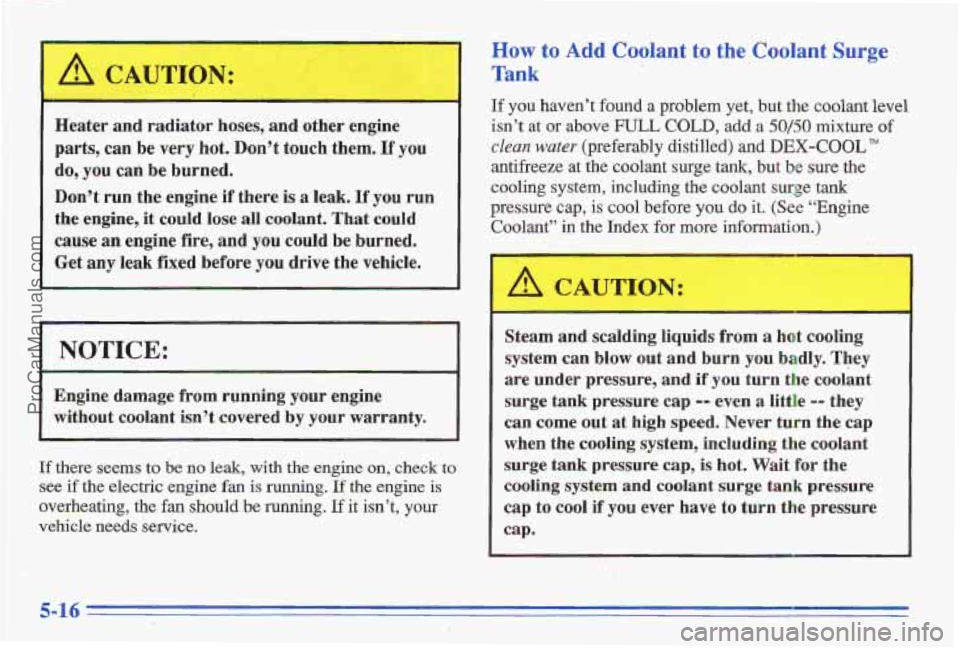
6!!l CAUTION:
~~~ ~
Heater and radiator hoses, and other engine
parts, can be very hot. Don’t touch them.
If you
do, you can be. burned.
Donst run the engine
if there is a leak. If you run
the engine, it could
lose all coolant. That coulld
cause an engine
fire, and you could be burned.
Get
any leak fixed before you drive the vehicle.
without coolant isn’t covered
by your warranty.
If there seems to be no leak, with the engine on, check to
see if the electric engine fan is running. If the engine is
overheating, the fan should be running. If it isn’t, your
vehicle needs service.
How to Add Coolant to the Coolant Surge
Tank
If you haven’t found a problem yet, but the coolant level
isn’t at
or above FULL COLD, add a 50150 mixture of
clean water (preferably distilled) and DEX-COOL
antifreeze at the coolant surge tank, but be sure the
cooling
system, including the coolant surge tank
pressure cap,
is COO^ before you do it, (See “Engine
Coolant” in the Index for more infomati .) - --
I
Steam and scalding liquids from a hot cooling
system can blow out and burn you badly. They
are under pressure, and
if you turn the coolant
surge tank pressure cap
-- even a little -- they
can come out at high speed. Never turn the cap
when the cooling
system, including the coolant
surge tank pressure
cap, is hot. Wait for the
cooling system and coolant
surge tank pressure.
cap to cool if you ever have to turn the pressure
cap.
5-16
ProCarManuals.com
Page 210 of 356
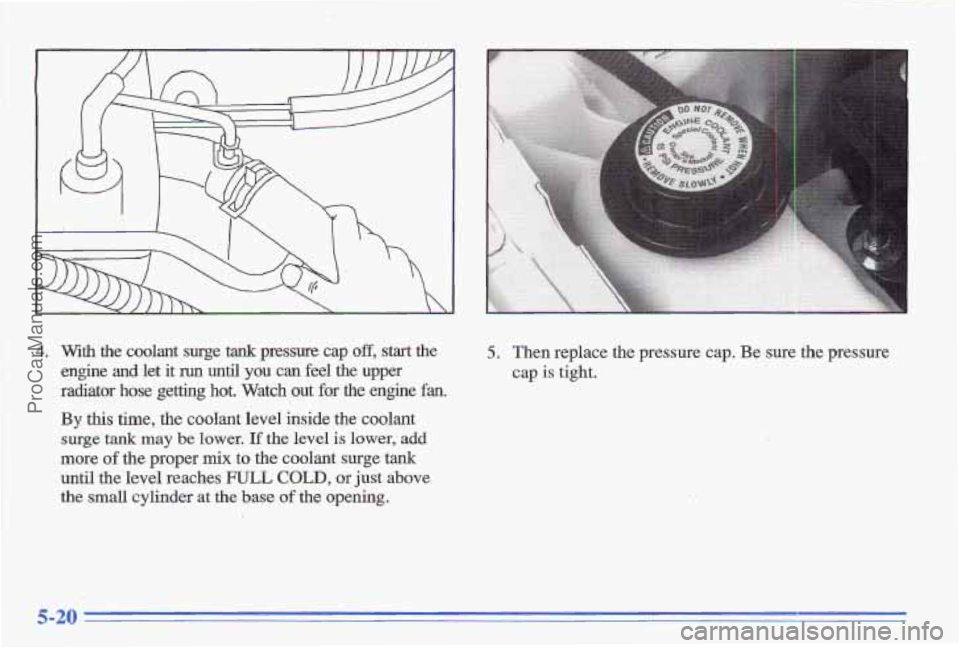
4. With the coolant surge tank pressure cap off, start the
engine and let it run until you can feel the upper
radiator hose
getting hot. Watch out for the engine fan,
By this time, the coolant level inside the coolant
surge tank may be lower. If the level is lower, add
more of the proper mix to the coolant surge tank
until the level reaches FULL COLD, or just above
the small cylinder at the base of the opening.
5. Then replace the pressure cap. Be sure the pressure
cap is tight.
ProCarManuals.com
Page 235 of 356
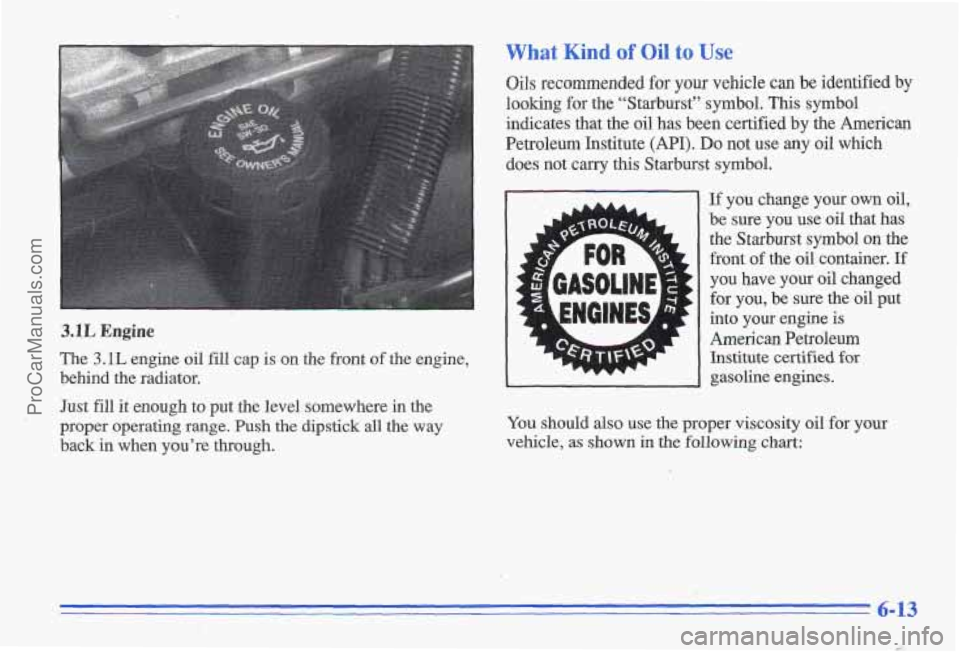
What Kind of’Oil to Use
3.1L Engine
The 3.1L engine oil fill cap is on the front of the engine,
behind the radiator.
Just fill it enough to put the level somewhere in the
proper operating range.
Push the dipstick all the way
back in when you’re through.
Oils recommended for your vehicle can be identified by
looking for the “Starburst” symbol. This symbol indicates that the oil has been certified by the American
Petroleum Institute
(API). Do not use any oil which
does not carry this Starburst symbol.
If you change your own oil,
be sure you use oil that has
the Starburst symbol on the front
of the oil container. If
you have your oil changed
for you, be sure the oil put
into your engine is
American Petroleum
Institute certified
for
gasoline engines.
You should also use the proper viscosity oil for your
vehicle, as shown
in the following chart:
6-13
ProCarManuals.com
Page 247 of 356

A CAUTION:
Turning the surge tank pressure cap when the
engine and radiator are hot can allow steam and
scalding liquids to blow out and burn you badly.
Never turn the surge tank pressure cap
-- even a
little -- when the engine and radiator are hot.
When your engine is cold, the coolant level should be at
the FULL
COLD mark, or a little higher.
If this light comes on,
means you’re low on engine
coolant.
See “LOW coolant Warning
Light” in the Index.
Adding Coolant
If you need more coolant, add the proper mix at the
surge tank, but only when the engine is cool.
I A CAUTION:
You can be burned if you spill coolant on hot
engine parts. Coolant contains ethylene glycol,
and it will burn if the engine parts are .hot
enough. Don’t spill coolant on
a hot engine.
~~
When replacing the pressure cap, make sure it is tight.
ProCarManuals.com
Page 248 of 356

Surge Tank Pressure Cap
NOTICE: ~~ ~
Your pressure cap is an 15 psi l(105 kPa)
pressure-type cap and must be tightly installed to
prevent coolant loss and possible engine damage
from overheating,
When you replace your surge tank pressure cap, a GM
cap is recommended.
Thermostat
Engine coolant temperature is controlled by a thermostat
in the engine coolant system, The thermostat stops the
flow of coolant through the radiator until the coolant
reaches
a preset temperature.
When you replace your thermostat,
an AC@ thermostat
is recommended.
Power Steering Fluid
When to Check Power Steering Fluid
It is not necessary to regularly check power steering
fluid unless
you suspect there is a leak in the system or
you hear an unusual noise. A fluid loss in this system
could indicate a problem. Have the system inspected
and
repaired.
6-26
ProCarManuals.com
Page 309 of 356
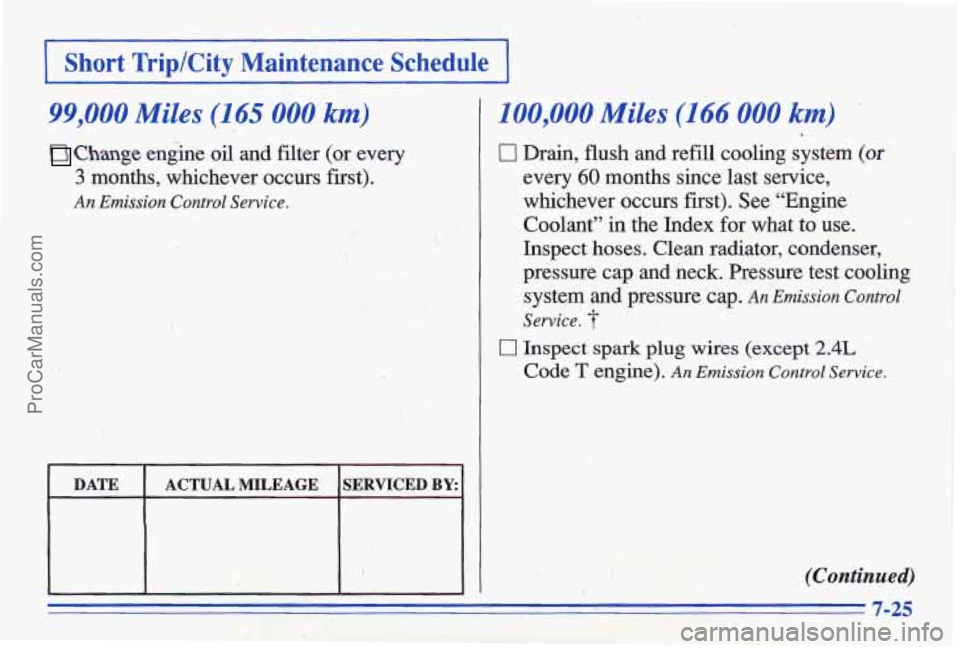
I Short Trip/City Maintenance Schedule I
99,000 Miles (145 000 km)
Change engine oil and filter (or every
3 months, whichever occurs first).
An Emission Control Service.
DATE
SERVICED BY: ACTUAL MILEAGE .
I
100,000 Miles (146 000 km)
0 Drain, flush and refill cooling system (or
every 60 months since last service,
whichever occurs first). See “Engine
Coolant” in the Index for
what to use.
Inspect hoses. Clean radiator, condenser,
pressure cap and neck. Pressure test cooling
system and pressure cap.
An Emission Control
Service.
0 Inspect spark plug wires (except 2.4L
Code T engine). An Emission Control Service.
(Continued)
7-25
ProCarManuals.com
Page 319 of 356

I Long Trip/Highway Maintenance Schedule
97,500 Miles (162 500 km)
Cbange engine oil and filter (or every
12 months, whichever occurs first).
An Emission Control Service.
and transaxle shift linkage (or every
12 months, whichever occurs first).
0 Lubricate the suspension, steering linkage
0 Rotate tires. See “Tire Inspection and
Rotation’’
in the Index for proper rotation
pattern and additional information. During
tire rotation, check brake calipers for
freedom of movement. Refer to the
appropriate
GM service manual for proper
caliper service procedures.
DATE SERVICED BY ACTUAL MILEAGE
100,000 Miles (166 000 km)
0 Drain, flush and refill cooling system (or
every 6‘0 months since last service,
whichever occurs first). See “Engine
Coolant” in the Index for what to use.
Inspect hoses. Clean radiator, condenser,
pressure cap and neck. Pressure test the cooling system and pressure cap.
An Emission
Control Service.
7
Inspect spark plug.wires (except 2.4L
Code T engine). An Emission Control Service.
(Continued)
7-35
ProCarManuals.com
Page 325 of 356
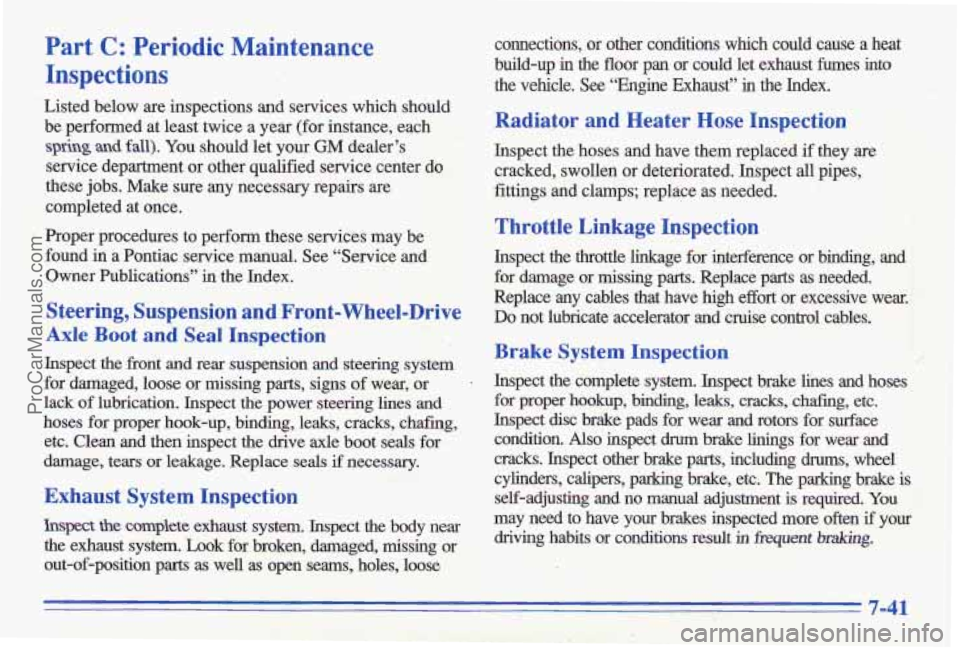
Part C: -Periodic Maintenance
Inspections connections, or other conditions which could cause a heat
build-up in
the floor pan or could let exhaust fumes into
the vehcle. See “Engine Exhaust”
in the Index.
Listed below are inspections and services which should
be performed at least twice a year (for instance, each
Radiator and Heater Hose Inspection
spxing and fall). You should let your GM dealer’+& ?::. Inspect the hoses and have them replaced if they are
service department or other qualified service center ,:5; 4
cracked, swollen or deteriorated. Inspect all pipes,
these jobs. Make sure any necessary repairs are fittings and clamps; replac\
e as needed.
completed at once.
Proper procedures to perform these services may be
found in a Pontiac service manual. See “Service and Inspect the throt\
tle linkage for interference or binding, and
. ..,..
Throttle Linkage Inspection
Owner Publications” in the Index.
Steering, Suspension and Front-Wheel-Drive
Axle Boot and Seal Inspection
Inspect the front and rear suspension and steering system
for.damaged, loose or missing parts, signs of wear, or
.
lack of lubrication. Inspect the power steering lines and
hoses for proper hook-up, binding, leaks, cracks, chafing,
etc. Clean and then inspect the drive axle boot seals for
damage,
tears or leakage. Replace seals if necessary.
Exhaust System Inspection
Inspect the colillplee exhaust system. Inspect the body near
the exhaust system. Look for broken, damaged, missing or
out-o€-position
parts as well as open seams, holes, loose fordamage
or missing parts. Replace parts
as needed.
Replace any cables that have high effort or excessive wear.
Do not lubricate accelerator and cruise control cables.
Brake System Inspection
Inspect the complete system. Inspect brake lines and hoses for proper
hookup, binding, leaks, cracks, chafhg, etc.
Inspect disc brake pads for wear and rotors for surface
condition.
Also inspect drum brake linings for. wear and
cracks. Inspect other brake parts, including
drums, wheel
cylinders, capers, parking brake, etc. The parking brake
is
self-adjusting and no manual adjustment is required. You
may need to have your brakes inspected more often if your
driving habits or conditions result
in fi-equent braking.
7-41
ProCarManuals.com